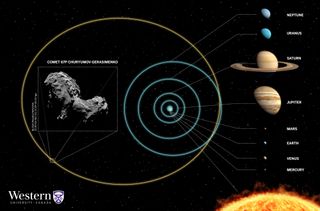
The comet that Europe's Rosetta spacecraft orbited for more than two years was probably born in the realm of icy bodies beyond Neptune, a new study suggests.
New analyses of the orbit of Comet 67P/Churyumov-Gerasimenko — on which Rosetta intentionally crash-landed on Sept. 30, ending the probe's historic mission — trace the object's origins back to the Kuiper Belt, whose most famous denizen is Pluto.
"These results come from computations of the comet's orbit from the present to the past, which is computationally difficult due to the chaosity of the orbit caused by close encounters with Jupiter," Mattia Galiazzo, a postdoctoral fellow in the Department of Physics and Astronomy at Western University in Ontario, Canada, said in a statement.
"Thus, the details are obscure, but we can establish a dynamical pathway from its current orbit back to the Kuiper Belt," added Galiazzo, who presented the findings Monday (Oct. 17) at the joint 48th annual meeting of the Division for Planetary Sciences (DPS) of the American Astronomical Society (AAS) and 11th annual European Planetary Science Congress (EPSC) in Pasadena, California.
Galiazzo and co-author Paul Wiegert, also of Western University, said they think the 2.5-mile-wide (4 kilometers) 67P, which takes about 6.5 years to orbit the sun, has been in the inner solar system just 10,000 years or so.
Comet 67P is a member of the "Jupiter family" or "short-period" comets, which coalesce far from the sun but veer into the inner solar system after collisions or gravitational interactions. Jupiter family comets don't stay in this neck of the woods for long — just 12,000 years on average, the researchers said. (Short-period comets are generally though to originate in the Kuiper Belt. "Long-period" comets, the other major type, are thought to originate much farther away, in a comet repository known as the Oort Cloud.)
Rosetta launched in March 2004, then took a long and looping route through the solar system before arriving at 67P in August 2014, becoming the first probe ever to orbit a comet. That November, Rosetta achieved another first, when the orbiting mothership dropped a washing-machine-sized lander onto the comet's surface.
Get the Space.com Newsletter
Breaking space news, the latest updates on rocket launches, skywatching events and more!
Follow Mike Wall on Twitter @michaeldwall and Google+. Follow us @Spacedotcom, Facebook or Google+. Originally published on Space.com.
Join our Space Forums to keep talking space on the latest missions, night sky and more! And if you have a news tip, correction or comment, let us know at: community@space.com.

Michael Wall is a Senior Space Writer with Space.com and joined the team in 2010. He primarily covers exoplanets, spaceflight and military space, but has been known to dabble in the space art beat. His book about the search for alien life, "Out There," was published on Nov. 13, 2018. Before becoming a science writer, Michael worked as a herpetologist and wildlife biologist. He has a Ph.D. in evolutionary biology from the University of Sydney, Australia, a bachelor's degree from the University of Arizona, and a graduate certificate in science writing from the University of California, Santa Cruz. To find out what his latest project is, you can follow Michael on Twitter.
